
In the realm of self-defense, The clash between traditional martial arts, exemplified by disciplines like Taekwondo, and the unregulated chaos of street fights pose a dynamic challenge. This comprehensive guide will delve into the nuanced dynamics of Taekwondo vs. Street Fight scenarios, exploring the principles, techniques, and adaptability required to navigate the complexities of real-world self-defense. By dissecting both worlds, we aim to equip individuals with the knowledge and skills necessary to effectively protect themselves in unpredictable situations. By understanding and applying Taekwondo principles in street fights, individuals can empower themselves with a versatile set of skills designed for both discipline and practical self-defense.
Taekwondo is an art known for its discipline and is often used in self-defense. If you learn and apply the fundamentals of Taekwondo, you can use its techniques to your advantage in street fights. Here are 5 steps that can help you better understand and use Taekwondo tactics in a street fight:
The Essence of Taekwondo
The Art of Taekwondo:
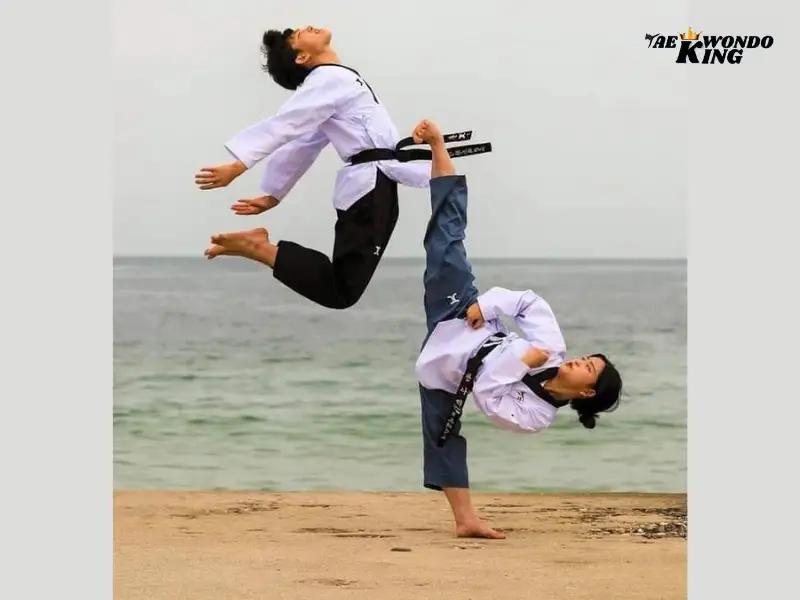
Taekwondo, originating in Korea, is renowned for its emphasis on high, fast kicks and dynamic movements. This section will provide an overview of the core tenets of Taekwondo, including its historical roots, philosophy, and the importance of discipline in training.
Taekwondo Techniques:
Delving into the specifics, this section will break down key Taekwondo techniques, such as kicks, strikes, and blocks. Understanding the mechanics behind these techniques is essential for appreciating their application in both controlled environments and the unpredictability of street fights.
Philosophy of Control and Discipline:
Taekwondo places a significant emphasis on control and discipline. This section will explore how the philosophy behind Taekwondo training extends beyond physical techniques, influencing mental fortitude, respect, and ethical conduct – attributes crucial for effective self-defense.
The Reality of Street Fights
Street Fight Dynamics:
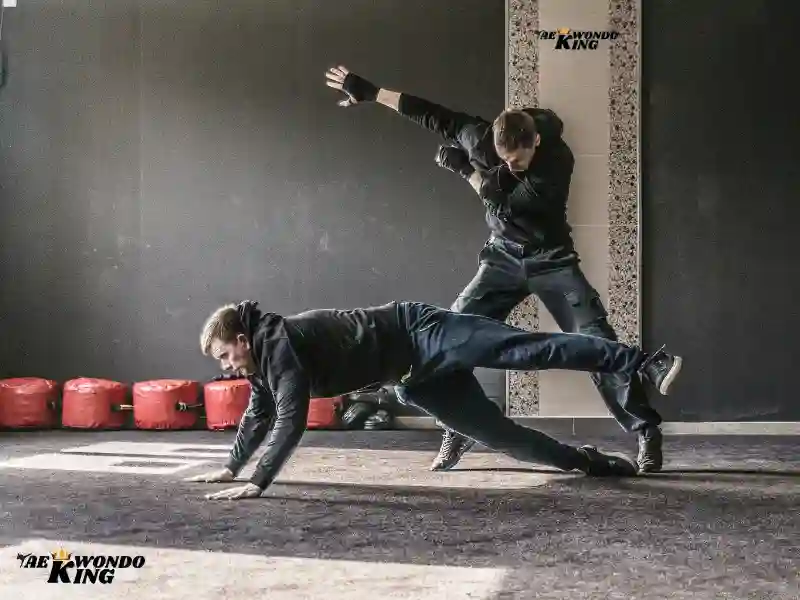
Street fights are chaotic and unpredictable. This section will delve into the dynamics of street fights, examining common scenarios, the psychology of attackers, and the rapid escalation that characterizes these confrontations.
Lack of Rules and Regulations:
Unlike the controlled environment of a martial arts studio, street fights lack rules and regulations. This section will explore how the absence of a structured framework impacts decision-making, tactics, and the overall approach to self-defense in street fight scenarios.
Multiple Opponents and Unpredictability:
Street fights often involve multiple opponents and unforeseen challenges. The complexities of facing multiple attackers and adapting to the unpredictable nature of street fights is crucial for effective self-defense strategies.
Understanding Taekwondo Techniques
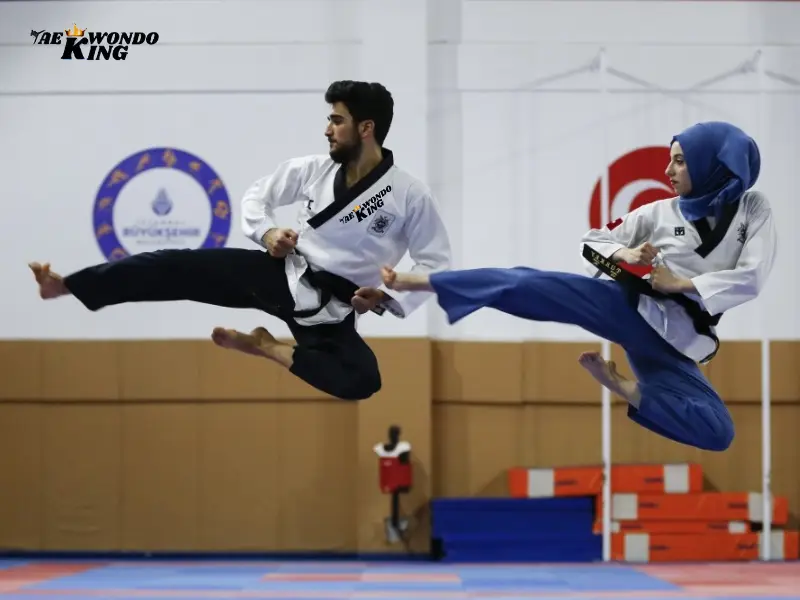
Kicks as Defensive Tools:
Taekwondo, renowned for its dynamic kicks, provides practitioners with a unique advantage in self-defense situations. From the front snap kick to the powerful roundhouse kick, mastering these techniques can create effective defensive barriers, keeping potential attackers at bay. We’ll explore the mechanics of these kicks and how to execute them with precision.
Hand Techniques for Close Combat:
While Taekwondo is often celebrated for its kicks, hand techniques play a crucial role in close combat scenarios. From punches to open-hand strikes, understanding the principles behind Taekwondo hand techniques enhances versatility in self-defense, especially in confined spaces where kicks may be impractical.
Footwork and Evasion:
Taekwondo places a significant emphasis on footwork, teaching practitioners how to move with agility and grace. This section will elaborate on the importance of footwork in street fights, including strategies for evasion, creating angles, and maintaining a defensive stance to control the flow of the confrontation.
Blocks and Counterattacks:
Mastering the art of blocking is fundamental in Taekwondo. This section will explore various blocking techniques and how they can be seamlessly integrated into counterattacks. Understanding the principles of blocking is crucial for turning an opponent’s aggression into an opportunity for a swift and effective counter.
Adapting Taekwondo for Street Fight Scenarios
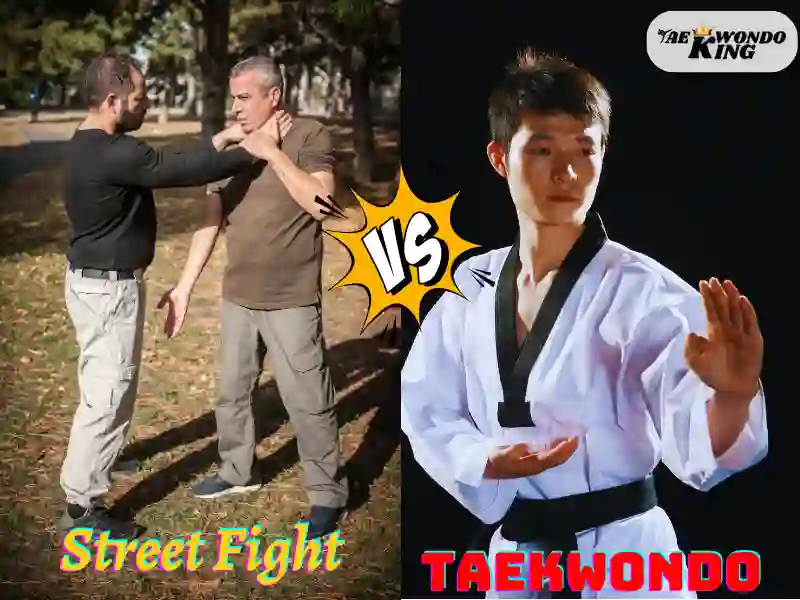
Situational Awareness:
The first line of defense in any street fight is situational awareness. Taekwondo instills discipline and mental focus, attributes that are invaluable in assessing potential threats. This section will guide readers on developing heightened awareness and maintaining a calm mindset in street fight scenarios.
Dealing with Multiple Attackers:
Street fights often involve multiple attackers, requiring a different approach from one-on-one confrontations. Taekwondo’s emphasis on fluid movements and quick strikes can be adapted for dealing with multiple opponents. This section will provide strategies for managing and neutralizing threats from multiple directions.
Ground Defense Techniques:
While Taekwondo is predominantly a standing martial art, its principles can be applied to ground defense. This section will explore techniques for getting back on your feet efficiently and using Taekwondo principles to create space for a safe recovery in street fight situations that end up on the ground.
Legal and Ethical Considerations:
Self-defense extends beyond physical techniques; it includes an understanding of legal and ethical considerations. This section will guide readers on when and how to use Taekwondo techniques responsibly, emphasizing the importance of proportionate force and the legal implications of self-defense.
Training Strategies for Real-world Applications
Scenario-Based Training:
Traditional Taekwondo training can be augmented with scenario-based exercises. This section will outline specific drills and training methods designed to simulate real-world street fight scenarios, allowing practitioners to apply their Taekwondo skills under realistic conditions.
Sparring and Pressure Testing:
Regular sparring is a cornerstone of Taekwondo training, and this section will emphasize its importance for practical self-defense. By engaging in controlled but dynamic sparring sessions, practitioners can pressure test their techniques, develop reflexes, and refine their ability to adapt to unpredictable situations.
Cross-Training in Complementary Disciplines:
To enhance the effectiveness of Taekwondo in street fight scenarios, cross-training in complementary disciplines is beneficial. This section will explore how incorporating elements of grappling, boxing, or other martial arts can round out a practitioner’s skill set, providing a more comprehensive approach to self-defense.
Advantages and Disadvantages of Taekwondo vs Street Fight
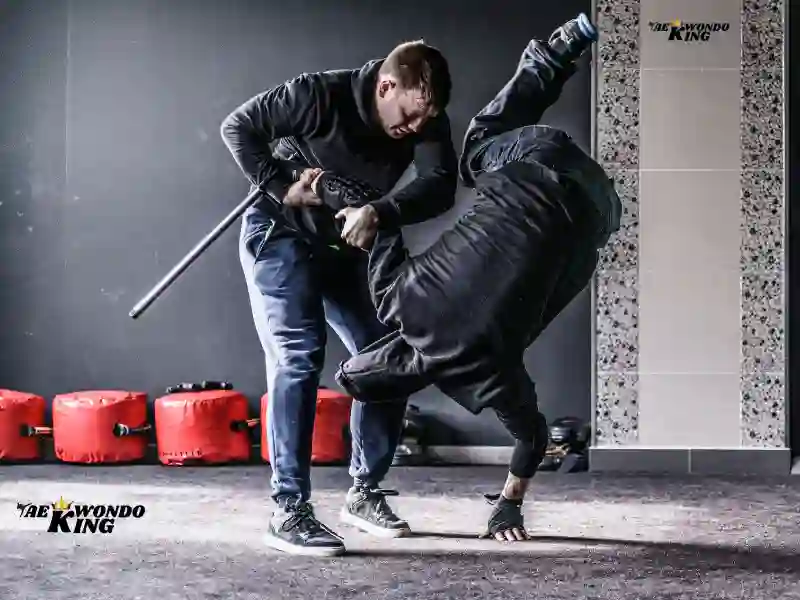
The quest for effective self-defense often leads individuals to weigh the advantages and disadvantages of traditional martial arts, represented by disciplines like Taekwondo, against the raw and unregulated nature of street fights. This comprehensive guide aims to unravel the intricacies of both realms, shedding light on the strengths and limitations of Taekwondo and contrasting them with the unpredictable dynamics of street fights.
Advantages of Taekwondo
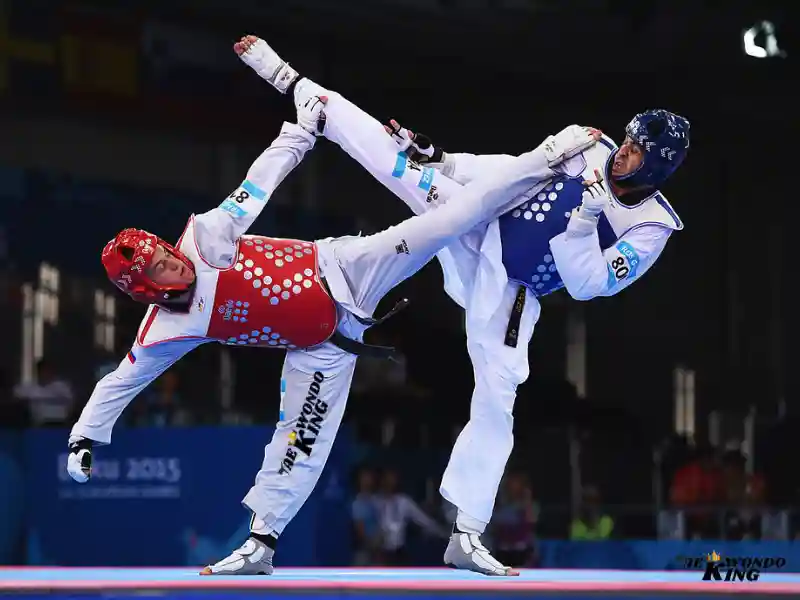
Discipline and Control:
Taekwondo, rooted in discipline and control, instills a structured approach to self-defense. This section will explore how the emphasis on mental fortitude and adherence to ethical principles contributes to a disciplined mindset, crucial for effective decision-making in confrontational situations.
Versatility in Kicking Techniques:
One of Taekwondo’s primary strengths lies in its versatile kicking techniques. This section will highlight the advantages of high, fast kicks, enabling practitioners to create distance, immobilize attackers, and control the pace of a confrontation.
Structured Training Environment:
Taekwondo provides a structured training environment, offering a systematic progression of techniques. This section will discuss how the organized curriculum and progressive training programs in Taekwondo contribute to a comprehensive skill set for self-defense.
Cultivation of Mental Toughness:
Mental toughness is a cornerstone of Taekwondo training. This section will delve into how the mental resilience developed through rigorous training prepares practitioners to remain focused, composed, and adaptable in high-pressure situations.
Disadvantages of Taekwondo

Limited Ground Defense Techniques:
While Taekwondo excels in standing techniques, its ground defense may be limited. This section will discuss the challenges practitioners may face in street fights that end up on the ground and explore strategies to overcome this limitation.
Complexity in Close Combat:
Taekwondo’s emphasis on kicks can pose challenges in close combat scenarios. This section will highlight how the need for a certain distance to execute kicks may limit effectiveness in confined spaces typical of street fights.
Sport vs. Real-world Application:
Taekwondo is often practiced as a sport with specific rules and regulations. This section will discuss the potential drawbacks of relying solely on sport-specific techniques and the need for adaptation when confronted with the unpredictable nature of street fights.
Advantages of Street Fight
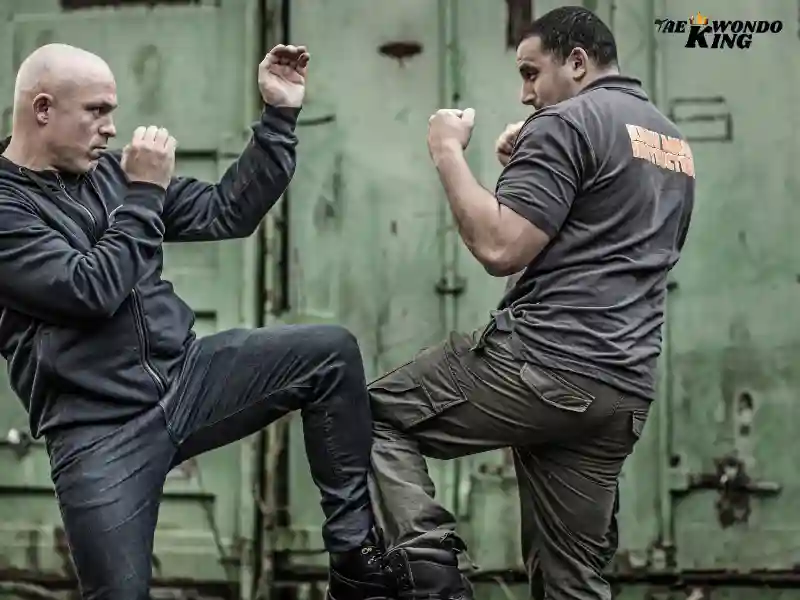
Unpredictable Nature:
Street fights are inherently unpredictable, posing challenges that may catch attackers off guard. This section will explore how the absence of rules and regulations in street fights can create an environment where adaptability and quick decision-making are paramount.
No Formal Training Needed:
In street fights, attackers may not possess formal training, providing an advantage to those who can adapt quickly. This section will discuss how individuals without formal martial arts training may leverage spontaneity and unpredictability to their advantage.
Use of Improvised Weapons:
Street fights may involve the use of improvised weapons or the environment itself. This section will highlight how individuals in street fights can utilize objects for self-defense, turning the surroundings into tools to gain an upper hand.
Disadvantages of Street Fight

Lack of Structure and Discipline:
Street fights lack the structure and discipline inherent in formal martial arts training. This section will discuss how the absence of a systematic approach may lead to uncontrolled aggression, hindering effective decision-making.
Risk of Legal Consequences:
Engaging in a street fight comes with legal risks. This section will explore the potential legal consequences individuals may face for using excessive force or causing harm, emphasizing the importance of responsible self-defense.
Inconsistency in Attackers’ Abilities:
Street fights may involve attackers with varying levels of skill and unpredictability. This section will discuss the challenge of adapting to inconsistent threats, from untrained individuals to those with some level of combat experience.
Choosing between Taekwondo and street fights for self-defense requires a nuanced understanding of the advantages and disadvantages each presents. By recognizing the strengths of Taekwondo in discipline, control, and versatile kicking techniques, individuals can harness a structured approach to self-defense. Simultaneously, an awareness of the unpredictable nature and spontaneity of street fights allows for adaptability and quick decision-making. Ultimately, a balanced approach that draws on the strengths of both realms can empower individuals with a comprehensive skill set for effective self-defense in diverse situations.
Taekwondo vs Street Fight, Can Taekwondo win in a Street Fight?
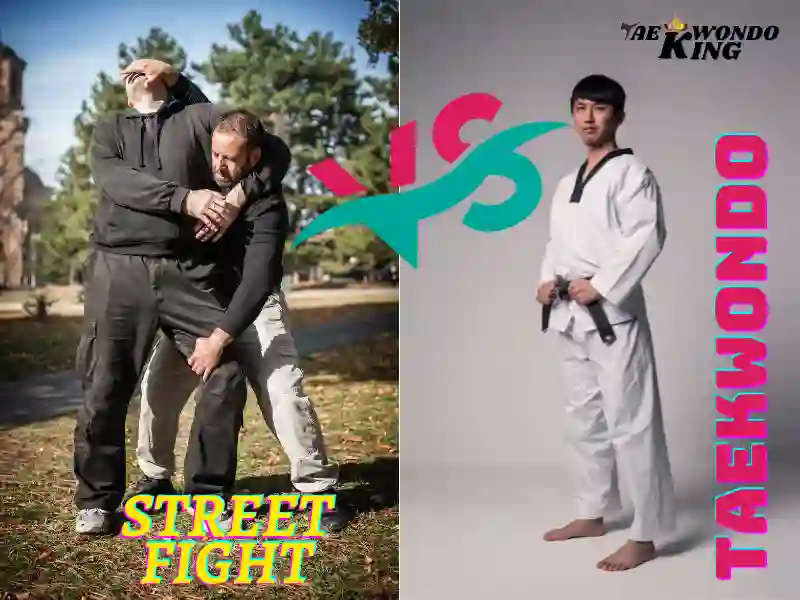
Taekwondo can be an effective form of self-defense, but it may not be the best choice for a street fight. Street fights are more chaotic and unpredictable than a typical Taekwondo sparring session, and the opponent could have a weapon. To have the best chance of success in a street fight, it is important to train in both self-defense and Taekwondo, using tactics and techniques that are designed to be effective in an unpredictable environment. Joint locks and throws may not be as effective in a street fight, as they require a certain level of skill and experience.
Who uses Taekwondo in Street Fighter?
Taekwondo is a popular Korean martial art used by many characters in the Street Fighter series of video games. Ryu, Ken, Chun Li, and Guile are all examples of characters who use taekwondo to fight their opponents. Taekwondo focuses on the use of powerful kicks and punches and can also be used defensively to counter an opponent’s attacks. Spinning heel kicks and flying back kicks are just some techniques used by the Street Fighter characters, making taekwondo an excellent choice of martial art for them.
Taekwondo vs Street Fight, Is Taekwondo useless in a real Street Fight?
While it’s true that Taekwondo is not designed to be used in a street fight, that doesn’t mean it’s completely useless. Taekwondo can help you develop skills such as defending yourself, recognizing danger, and staying composed under pressure. It also provides physical conditioning and mental discipline that can be beneficial in a fight. So while Taekwondo may not be a guaranteed solution, it can still be a useful tool in protecting yourself.
Does Taekwondo teach you how to fight?
Taekwondo is an amazing martial art that provides more than just a physical workout. It teaches its practitioners respect, discipline, and self-improvement, as well as providing physical and mental health benefits. It’s also a great way to build self-confidence, learn discipline, and achieve goals.
Is Taekwondo attacking or defensive?
Taekwondo is a form of martial arts that combines physical and mental training. It teaches you how to use your body and mind to defend yourself, focusing on kicking and punching techniques. Taekwondo also emphasizes being mindful and aware of your environment so that you can react quickly and effectively. With the right amount of training, it can be a powerful tool for self-defense.
Taekwondo vs Street Fight, Is Taekwondo Effective in a Street Fight?
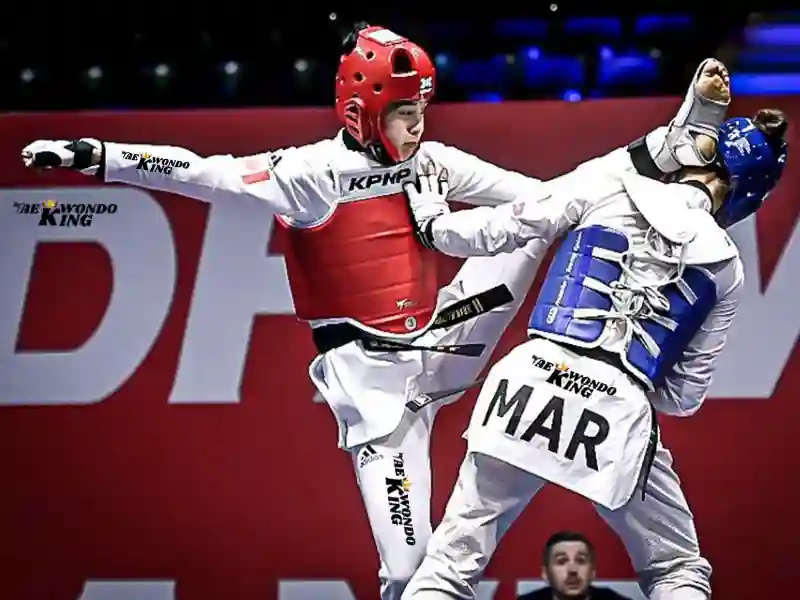
TKD is a form of martial arts that focuses on kicking and striking techniques as an effective self-defense system. While kicks are a powerful weapon in street fights, other aspects of Taekwondo can be used as well. Taekwondo teaches practitioners how to move their bodies for an advantage, block, and counter strikes from a distance, and maintain balance and posture to stay in control of the situation. So, although Taekwondo is effective in a street fight, it is important to use it properly and with caution.
Is Taekwondo effective for self-defense?
Taekwondo is an excellent way to learn self-defense. It is a martial art that focuses on effective kicking and blocking techniques. It helps you to improve physical strength, coordination, agility, and balance and teaches you how to use your body that is less likely to cause harm to an attacker. With Taekwondo, you can learn how to defend yourself against multiple attackers and get away quickly. Additionally, it can also help to develop your mental and emotional strength, as you learn to control your emotions and stay focused when facing a threat. So, if you’re looking for an effective way to learn self-defense, Taekwondo is worth a try!
Is it good for kids to learn Taekwondo?
Taekwondo is an excellent martial art for children to learn! Not only does it teach respect and discipline, but it also helps to improve coordination and balance, physical fitness, mental focus, and concentration, as well as confidence and self-esteem. It is also a great way for children to learn self-defense and stay safe while developing the skills to stay calm in difficult situations and problem-solve. Plus, it is a great way for children to develop socially and build friendships. Taekwondo is an excellent martial art for children to learn.
Is Taekwondo useful in a real Fight?
Yes, Taekwondo is a powerful and effective form of self-defense that can be used in a real fight. It teaches you how to block and parry attacks, how to strike efficiently, and how to control or evade an opponent. It also teaches you how to properly evaluate a situation and how to respond accordingly.
Is Taekwondo effective in MMA?
Taekwondo is an ancient martial art that has been used for many years to defend oneself. In recent years, it has gained popularity as an effective way to train for Mixed Martial Arts (MMA). Taekwondo is a significant form of martial art that can help you become a well-rounded and skilled fighter. It is a great way to build your physical strength and stamina, as well as your mental discipline. Additionally, taekwondo can help you learn to defend yourself in a variety of situations. Its combination of strikes, blocks, throws, and joint manipulation techniques make it an excellent choice for those wishing to become successful MMA fighters.
Why Taekwondo is bad?
Taekwondo is an ancient martial art that can be dangerous if not practiced with proper instruction and supervision. It can be used as an effective form of self-defense, but the intensity and physical contact involved can lead to serious injury, particularly in young children.
Additionally, Taekwondo can be used to intimidate or hurt other people, making it a potentially dangerous activity. It is important to be aware of the potential for serious injury if one is not properly trained, and Taekwondo does not always teach its practitioners values such as respect, self-control, and discipline, which are important for any martial artist to learn. Because of this, Taekwondo should be practiced with caution.
Conclusion:
Learning how to use Taekwondo techniques in street fight scenarios is a journey that requires dedication, discipline, and adaptability. By understanding the principles of Taekwondo and tailoring its techniques to the unpredictable nature of street fights, individuals can empower themselves with a versatile skill set for self-defense. This guide serves as a roadmap for practitioners, emphasizing the importance of ongoing training, situational awareness, and ethical considerations to navigate real-world confrontations successfully.
FAQ
How do you get the advantage in a street fight?
Street fights can be very dangerous, so it’s essential to know how to protect yourself. Being prepared and using moral judgment is key to getting an edge in such a situation. If you’re ever confronted with violence, try to stay calm and look for an escape. Also If you can’t avoid the situation, then efficiently use your body and be prepared to strike quickly. If you have any weapons available, such as a stick or pepper spray, use them. Be aware that some of your assailants may also be armed, so be ready to fight back or look for a way to get out of there. Keep your focus and be brave, and you may just come out on top.
Can Karate defeat Taekwondo?
It is difficult to say which martial art is better between karate and Taekwondo as both have different techniques and philosophies. Ultimately, the style that works best for you depends on your individual goals and needs. Karate focuses on striking and blocking techniques, while Taekwondo is a more modern style that focuses on high-impact kicking and punching techniques. Many martial artists practice both styles, so the best martial art for any individual is the one that works best for them.
Does Taekwondo work in real combat?
Taekwondo is an effective martial art that can be used as self-defense in real-world scenarios. It has a range of techniques, including kicks, punches, joint locks, and throws, that can be used to counter any attack. Additionally, Taekwondo can be used as physical exercise, helping practitioners to become physically fit and agile. It also helps to cultivate mental discipline, including respect for opponents and self-control, which can be beneficial in heated situations. As a result, Taekwondo can be an effective tool for self-defense.
Taekwondo vs Boxing
Taekwondo and boxing are two very different fighting styles. TKD is a martial art that employs kicks, punches, and blocks to defend oneself. It is mainly viewed as a self-defense system and requires quick reflexes and agility. On the other hand, boxing is a sport that relies on punches, jabs, and hooks. It is seen as a more aggressive form of fighting and can be highly competitive.
Both styles have their benefits and drawbacks, so it is important to understand and appreciate them. For instance, Taekwondo gives practitioners the means to defend themselves in multiple ways, while boxing can help enhance a fighter’s strength and technique. Ultimately, the choice between Taekwondo and boxing should be based on a person’s skills and needs.
Taekwondo vs Jiu-jitsu
Taekwondo and Jiu-jitsu are two popular forms of martial arts. Both have similarities, but they also have distinct differences. Taekwondo emphasizes defense and focuses on kicking and blocking techniques, while Jiu-jitsu is more aggressive and offensive, with an emphasis on grappling and submission techniques. Taekwondo is often seen as better for self-defense, while Jiu-jitsu is more suitable for competition and training. Both can be used for combat, but depending on what you are looking for, one is likely to be better suited for your purpose.
Taekwondo vs Karate
Taekwondo and Karate are two popular martial arts styles practiced around the world. While they share some similarities, there are also key differences between them. Taekwondo is a Korean martial art focused on fast-paced, powerful kicks and punches, while Karate is a Japanese martial art focused on strong blocks and strikes. Taekwondo is generally considered more offensive while Karate is more defensive. Additionally, Taekwondo emphasizes sparring and tournaments to test practitioners’ skills, while Karate emphasizes self-defense and practical application. No matter which style you choose, you can benefit from learning discipline, self-defense, and physical fitness.
Taekwondo vs Muay Thai
Taekwondo and Muay Thai are both martial arts that have been around for a long time. Both martial arts focus on self-defense, striking, kicking, and throwing. Taekwondo focuses on kicks and strikes, while Muay Thai puts more emphasis on clinch and throwing techniques. Taekwondo is more defensive and uses evasive maneuvers, while Muay Thai is known for its aggressive and powerful strikes. Ultimately, the decision between the two comes down to personal preference and what you hope to achieve from practicing martial arts. Both martial arts have their advantages and disadvantages and can be used for self-defense and competition.
Is Taekwondo a joke?
Taekwondo is a serious martial art form that has been around for centuries. It requires strength, stamina, skill, dedication, and adherence to a strict code of honor and respect to excel. Proper technique and safety must also be practiced. Taekwondo is not a joke–it is an art that must be taken seriously.
Taekwondo vs Street Fight, Does Taekwondo Work in a Street Fight?
A common question many people have when considering martial arts is if they can use it in a street fight. The answer is yes, any type of martial art can be used in a street fight, but it is important to understand that it may not work as you expect. Taekwondo is a martial art that emphasizes kicking and striking and can be very effective against a single assailant. However, against multiple attackers, it may be less successful. It is important to consider your safety and the skills of your opponent before engaging in a physical altercation.

Founder, Owner, and CEO of TaekwondoKing.
He is one of the top 100 martial artists in the World and among the top 20 referees in Bangladesh.
Ehatasamul Alom is an esteemed Kukkiwon Certified Taekwondo 3rd Dan Black Belt with over 15 years of experience in this dynamic martial art. Born in Rajshahi, Bangladesh, Ehatasamul’s journey with Taekwondo began at the tender age of seven. His passion led him to compete at national and international levels, where he has bagged numerous awards and honors. He is also a member of the Taekwondo National Referee Panel.
With a Bachelor’s degree in Sports Science from the prestigious Rajshahi University, Ehatasamul has a deep understanding of the technical and scientific aspects of martial arts and some other martial arts.
In 2022, Ehatasamul created the “TaekwondoKing.com” to share his knowledge, Free Resources, Values, and Real experiences. His articles focus on Taekwondo training techniques, competition strategies, Sport Products Reviews, and the art’s rich history and philosophy. He also writes about the importance of mental fortitude and discipline, key aspects of his teaching philosophy. He has already launched many sports, Taekwondo, and health-related Free online tools. His goal is to inspire both beginners and seasoned practitioners worldwide through insightful and engaging content.
If you need any help, contact Ehatasamul Alom at any time.


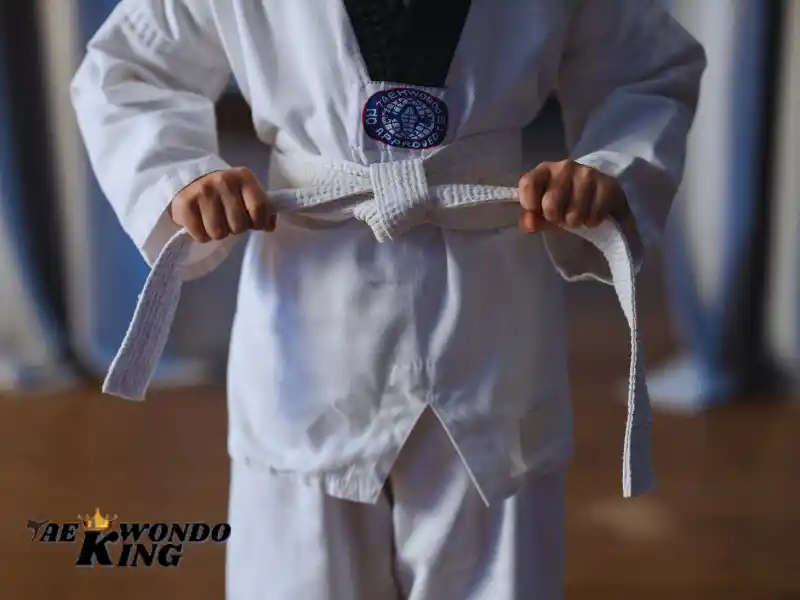


I am TaeKwon-Do Master Edward Brian Scott, we all learn ITF TaeKwon-Do do that we can avoid any confrontation, especially within the community! The idea of being in a confrontation is to first take note of your environment and communicate your way out of the confrontation, and have your hands on house or car keys to use at a moments notice, but we must remember in a situation like this you have to accept the consequences that a serious injury will occur or even death to yourself or your assailant, and you have to live with that, or even be charged with manslaughter, grevious bodily harm or murder. Depending on what country your live in, you could face jail time, imprisonment and a lengthy court trial?
Learn ITF TaeKwon-Do for continued good health, happiness and the joy of life.
Thanks for sharing. I read many of your blog posts, cool, your blog is very good.